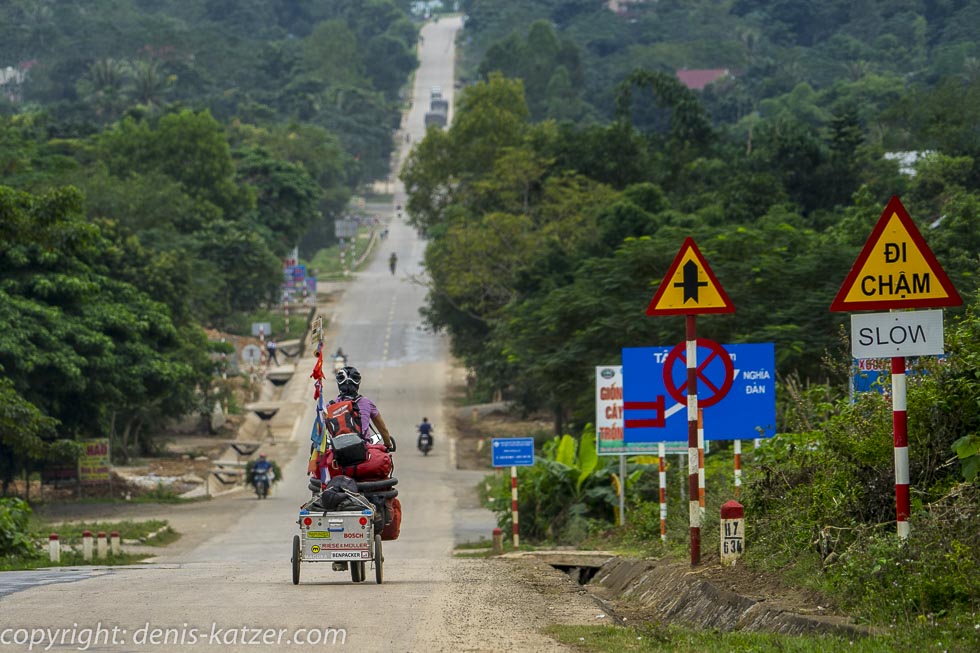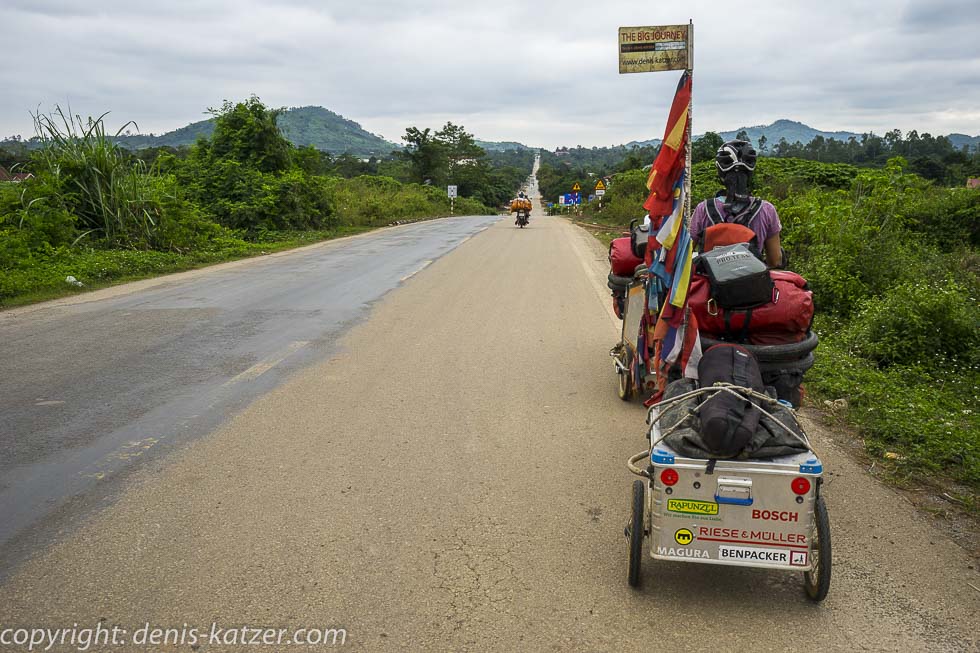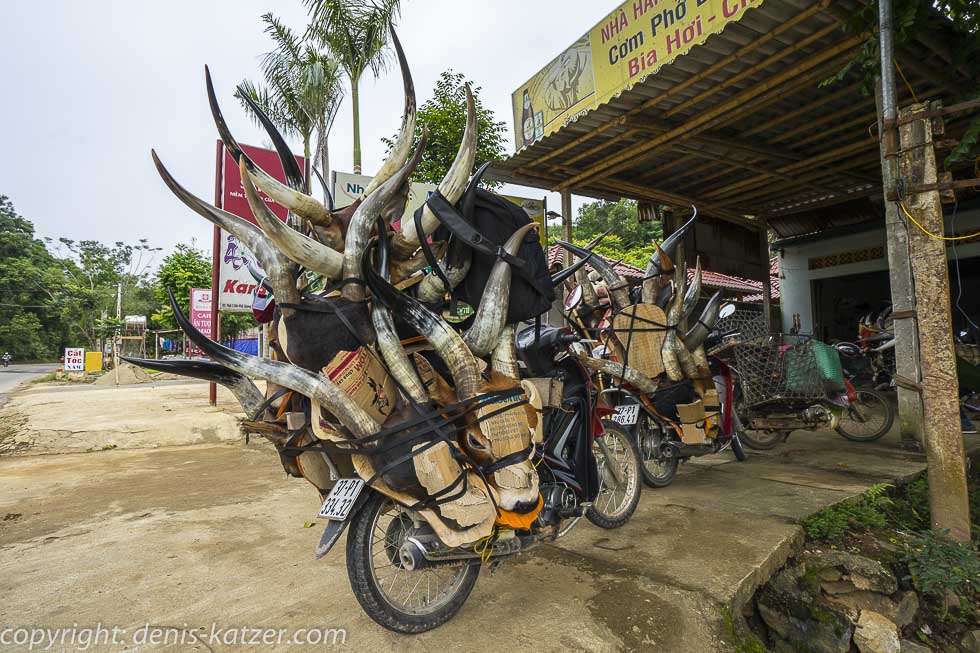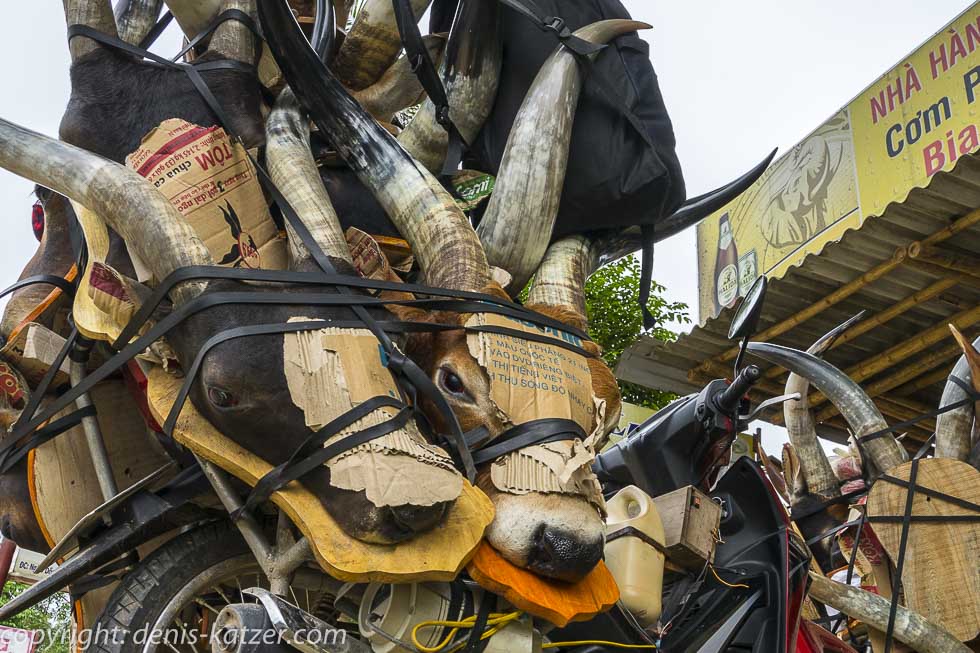
South on the famous Ho Chi Minh Highway
N 19°55'10.3'' E 105°23'37.8''
Date:
11.11.2016
Day: 504
Country:
Vietnam
Province:
Thanh Hóa
Location:
Vu Ban
Latitude N:
19°55’10.3”
Longitude E:
105°23’37.8”
Daily kilometers:
85 km
Total kilometers:
20,517 km
As the crow flies:
61 km
Average speed:
24.3 km
Maximum speed:
43.7 km/h
Travel time:
3:27 hrs.
Soil condition:
Asphalt
Maximum height:
100 m
Total altitude meters:
56.205 m
Altitude meters for the day:
437 m
Sunrise:
06:04
Sunset:
5:20 pm
Temperature day max:
20°C
Departure:
09:20 a.m.
Arrival time:
2:30 pm
(Photos of the diary entry can be found at the end of the text).
When we left the narrow mountain road behind us yesterday, we came across the famous Ho Chi Minh Highway with its little traffic, which runs along sections of the famous Ho Chi Minh Trail and will take us to the south of Vietnam over the coming weeks. During the last Vietnam War, this region was covered by a logistical network of 16,000 kilometers of trails and small roads stretching from North to South Vietnam. For the communist troops of North Vietnam – the “Vietcong” – the secret transportation network leading through the jungle was of great importance. They used guerrilla tactics against the US army in the south and to supply the South Vietnam Liberation Front there with logistics. For tactical reasons, parts of the Ho Chi Minh Trail were relocated to the neighboring countries of Laos and Cambodia. Although these two countries remained neutral during the terrible war, the Americans extended the attacks into the uninvolved countries in order to drown the supply routes under an endless hail of bombs. However, the Vietnamese soldiers’ will to freedom was so strong that they smuggled hundreds of tons of material along the Ho Chi Minh Trail every day, despite the constant air attacks by US warplanes. In order to put an end to these supply lines, the US army decided to destroy the jungle with the chemical defoliant Agent Orange. In this way, the road network became visible and could be attacked directly by the Luftwaffe. Over 6000 poison missions were flown between 1965 and April 1970. The US armed forces sprayed a total of 45,677,937 liters of Agent Orange. Primeval forests and harvests were destroyed. Large parts of the country were permanently poisoned for future generations and yet the Americans were unable to break the will of the people. As soon as paths and roads were destroyed, they were relocated to undestroyed jungle regions or into an elaborately dug tunnel system up to 9 meters deep underground. This allowed the transportation of Vietcong soldiers and goods to continue to the south.
During a short break, we gaze silently across the Chu River, which has made its way here from Laos through the dense primeval forests. “I’m stunned,” says Tanja after I tell her the results of my research on the Ho Chi Minh Highway. “I simply cannot understand why none of the American politicians and military officers responsible at the time have ever been punished and imprisoned for this monstrous war crime,” I say thoughtfully. “That’s probably because a world power can get away with anything,” answers Tanja. “Those who have the money and the power can bend the law until it suits them. Apparently that has always been the case. I hope there is a future for humanity in which such atrocities and criminal wars are not repeated over and over again. At some point, even the stupidest person has to understand that this aggressive, power-hungry behaviour is deadly for everyone involved and that the human race, regardless of skin color, will have no future,” I say, thinking of the incomprehensible outcome of the recent US elections, the war in Syria, Ukraine, Afghanistan, Yemen, etc(According to a publication on Wikipedia, there are currently armed conflicts on 5 out of 7 continents (excluding Australia and Antarctica). In 2014, 164,000 – 220,000 people worldwide died directly from combat operations, the highest number in 26 years. At least 167,000 people died in conflict zones in 2015. Over 5 of the 7.3 billion people live in states where there are armed conflicts).
The great mountains are behind us for the time being. The Ho Chi Minh Highway, called Truong Son Road by the locals because of the Truong Son Mountains, leads through a still beautiful and peaceful landscape without any major elevations. There is no sign of the atrocities committed by the Americans, at least not on the section of road we are currently cycling through. The mountains here are only around 500 to 600 meters high and line the two-lane asphalt strip. This is the first time since crossing the Gobi Desert in Mongolia that we have been able to glide along a relatively straight stretch of road at around 27 km/h again. In turbo mode, we manage around 40 km with one battery. For us, this means that in an emergency we can travel up to 240 kilometers without having to recharge.
We reach a run-down hotel in the afternoon. The rooms are damp and smell strongly of mold. The reality of traveling has returned to us, I think. Because of the long stay in Mai Chau and my shoulder injury, I’m not in good shape. And although we didn’t have to climb any mountains today, we can still feel the 85 kilometers we’ve covered. “Can we bring the bikes into the house?” is my usual question. After a long back and forth, the woman points to a former abandoned gatehouse. Only after we have carried our equipment into the room do we roll the bikes to their overnight accommodation, where the door can be locked but the sliding windows have no lock. “You can simply slide them open, reach through and open the door from the inside,” Tanja notes. Although our precious bikes could easily be stolen, we decide to stay here. “Don’t think anyone will come here to steal them,” Tanja is convinced, although we have now met a few travelers who have had their bikes stolen from the lobby of a hotel and from a locked courtyard, even though they were secured with multiple locks. “I’ll be fine,” I reply, tying the bikes together with our cable locks and covering them with the tarpaulin.
“Oh no! My camp chair is broken,” I shout in horror as I’m about to set it up to type my daily notes into the laptop. “Can you fix it?” asks Tanja. “No chance, but I saw a moped repair shop next to the hotel. The guys are usually quite resourceful. Maybe they’ll think of something,” I reply, grab my beloved, well-traveled old folding chair and leave the room. “Can you fix it?” I ask the young mechanic hopefully. He immediately interrupts his work on a rusty moped and grabs the chair without comment. A second mechanic shuffles over and watches his colleague. A woman comes out of the kitchen to join the group. Kraaack!, it suddenly rattles, almost making my heart stop in shock. I only feel a breeze, then the man has sped past me on his moped. Klooong!, it rattles again as he hammers his pile of rust into a brand new moped. Doooock!, it sounds as the front tire of the frail vehicle crashes into an open crate and comes to a halt. We stare in amazement at the man, who is now grinning as he gets off his buck. “The brake is broken!” I understand, to which everyone present laughs heartily. No one seems to mind that the man almost ran me over and that the mudguard of my brand new moped was demolished. As if nothing had happened, the mechanic looks at my beloved camp chair. Then he fetches a drill, a small pipe clamp and digs an old screw out of a box. Just five minutes later, my chair is repaired in a brute force manner. “Great. Thank you very much,” I say happily and ask what he wants for his efforts. “20,000 dong” (€0.84), he replies and invites me for a cup of green tea. The other mechanics, the woman and the customer who almost knocked me down, also sit down at the small table surrounded by mopeds, tools and old sheet metal parts. Although we can hardly communicate, I am able to explain where I come from and where we are going. When they see the pictures of our bikes and Ajaci on my smartphone and understand that we’ve cycled from Germany to Vietnam, they don’t want to let me go. My tiny teacup is filled again and again and the water pipe circles from hand to hand. The workshop occupants bombard me with lots of questions. Half an hour later I’m back at Tanja’s and tell her about my adventure and how lucky I was not to have been run over in a garage…
If you would like to find out more about our adventures, you can find our books under this link.
The live coverage is supported by the companies Gesat GmbH: www.gesat.com and roda computer GmbH http://roda-computer.com/ The satellite telephone Explorer 300 from Gesat and the rugged notebook Pegasus RP9 from Roda are the pillars of the transmission. Pegasus RP9 from Roda are the pillars of the transmission.






